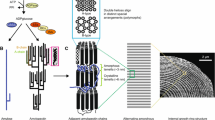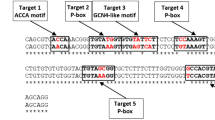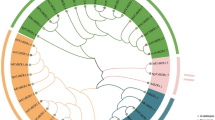Abstract
The cellular myo-inositol (Ins) pool is important to many metabolic and signaling pathways in plants. Ins monophosphatase (IMPase; EC 3.1.3.25) activity is essential for the de novo synthesis of myo-Inositol (Ins), and for recycling of Ins in Ins(1,4,5)P3. However, proteins encoded by at least one family of IMP genes also have l-galactose-1-P phosphatase activity important to ascorbic acid synthesis, indicating a bifunctionality that links these two branches of carbon metabolism. As part of research into the regulation of Ins synthesis and supply during seed development, the barley IMP-1 gene and gene products were studied. The 1.4 kb barley IMP-1 promoter contains one low temperature response element (RE), two heat shock REs, one gibberellin and two auxin REs, and five sugar REs. Barley IMP-1 is expressed in all tissues assayed, and expression levels were not greatly altered by abiotic stress treatments. Reduced use of Ins for Ins P6 synthesis in developing seed of barley low phytic acid (lpa) mutants results in Ins accumulation, and IMP-1 expression is reduced in proportion to the increase in Ins level. The barley recombinant enzyme had a lower Km, indicating higher affinity, for d/l-Ins(3)P1 (Km = 9.7 μM) as compared with reported Km (Ins P1) values for other eukaryotic IMPases (43–330 μM) or with a reported Km (l-Gal-1P) of 150 μM for a kiwifruit (Actinidia deliciosa) enzyme. These and other data indicate that the barley IMP-1 gene is regulated at least in part in response to Ins metabolic needs, and that the enzyme it encodes displays catalytic properties well suited for a role in Ins synthesis, in addition to other roles as an l-gal-1-P phosphatase important to ascorbate synthesis, or as an IMPase important to Ins(1,4,5)P3 signal recycling.








Similar content being viewed by others
Notes
With the exception of the use of “d/l” mixtures used in enzyme assays, all Ins phosphates will be referred to here using the “d”-numbering convention; d-Ins(3)P1 is identical to l-Ins(1)P1.
Abbreviations
- CTAB:
-
Hexadecyltrimethylammonium bromide
- HEPES:
-
N-2-Hydroxyethylpiperazine-N′-2-ethane-sulfonic acid
- Ins:
-
myo-Inositol
- lpa :
-
Low phytic acid
- Ins P6 :
-
myo-Inositol-1,2,3,4,5,6-hexakisphosphate
- IPTG:
-
Isopropyl β-d-thiogalactoside
- MIPS:
-
myo-Inositol-3-phosphate synthase
- IMPase:
-
myo-Inositol monophosphatase
References
Arai R, Ito K, Ohnishi T, Ohba H, Akasaka R, Bessho Y, Hanawa-Suetsuga K, Yoshikawa T, Shirouzu M, Yokoyama S (2007) Crystal structure of human myo-inositol monophosphatase 2, the product of the putative susceptibility gene for bipolar disorder, schizophrenia, and febrile seizures. Proteins 67:732–742
Berridge G, Downes CP, Hanley MR (1989) Neural and developmental actions of lithium; a unifying hypothesis. Cell 59:411–419
Bowen DE, Guttieri MJ, Peterson K, Peterson K, Raboy V, Souza EJ (2006) Phosphorus fractions in developing seeds of four low phytate barley (Hordeum vulgare L.) genotypes. Crop Sci 46:2468–2473
Bradford MM (1976) A rapid and sensitive method for the quantitation of microgram quantities of protein using the principle of protein-dye binding. Anal Biochem 72:248–254
Chen I-W, Charalampous FC (1966) Biochemical studies on inositol IX. d-Inositol 1-phosphate as intermediate in the biosynthesis of inositol from glucose 6-phosphate and characteristics of two reactions in this biosynthesis. J Biol Chem 241:2194–2199
Chen L, Roberts MF (2000) Overexpression, purification, and analysis of complementation behavior of E. coli SuhB protein: comparison with bacterial and archaeal inositol monophosphatases. Biochemistry 39:4145–4153
Chirgwin JM, Przybyla AE, MacDonald RJ, Rutter WJ (1979) Isolation of biologically active ribonucleic acid from sources enriched in ribonuclease. Biochemistry 18:5294–5299
Cohen JD, Bandurski RS (1982) Chemistry and physiology of the bound auxins. Annu Rev Plant Physiol 33:403–430
Conklin PL, Gatzek S, Wheeler GL, Dowdle J, Raymond MJ, Rolinski S, Isupov M, Littlechild JA, Smirnoff N (2006) Arabidopsis thaliana VTC4 encodes L23 galactose-1-P phosphatase, a plant ascorbic acid biosynthetic enzyme. J Biol Chem 281:15662–15670
Dellaporta Sl, Wood J, Hicks JB (1983) A plant DNA minipreparation: version II. Plant Mol Biol Rep 1:19–21
Diehl ER, Whiting P, Potter J, Gee N, Ragan CI, Linemeyer D, Schoepfer R, Bennett C, Dixon AFR (1990) Cloning and expression of bovine brain inositol monophosphatase. J Biol Chem 265:5946–5949
Dorsch AJ, Cook A, Young AK, Anderson NJ, Bauman TA, Volkmann JC, Murthy PNP, Raboy V (2003) Seed phosphorus and inositol phosphate phenotype of barley low phytic acid genotypes. Phytochemistry 62:691–706
Gasteiger E, Hoogland C, Gattiker A, Duvaud S, Wilkins MR, Appel RD, Bairoch A (2005). Protein identification and analysis tools on the ExPASy server. In: Walker JM (ed) The proteomics protocols handbook. Humana Press, NJ
Gillaspy GE, Gruissem W (2001) Li+ induces hypertropy and down regulation of myo-inositol monophosphatase in tomato. J Plant Growth Regul 20:78–86
Gillaspy GE, Keddie JS, Oda K, Gruissem W (1995) Plant inositol monophosphatase is a lithium-sensitive enzyme encoded by a multigene family. Plant Cell 7:2175–2185
Giuliano G, Pichersky E, Malik VS, Timko MP, Scolnic PA, Cashmore AR (1988) An evolutionarily conserved protein binding sequence upstream of a plant light-regulated gene. Proc Natl Acad Sci USA 85:7089–7093
Grierson C, Du J-S, de Torres Zabala M, Beggs K, Smith C, Holdsworth M, Bevan MW (1994) Separate cis sequences and trans factors direct metabolic and developmental regulation of a potato tuber storage protein gene. Plant J 5:815–826
Higo K, Ugawa Y, Iwamoto M, Korenaga T (1999) Plant cis-acting regulatory DNA elements (PLACE) database. Nucleic Acids Res 27:297–300
Hitz WD, Carlson TJ, Kerr PS, Sebastian SA (2002) Biochemical and molecular characterization of a mutation that confers a decreased raffinosaccharide and phytic acid phenotype on soybean seeds. Plant Physiol 128:650–660
Hwang Y-S, Karrer EE, Thomas BR, Chen L, Rodriguez RL (1998) Three cis elements required for rice-amylase Amy3D expression during sugar starvation. Plant Mol Biol 36:331–341
Ishitani M, Majumder AL, Bornhouser A, Michalowski CB, Jensen RG, Bohnert HJ (1996) Coordinate transcriptional induction of myo-inositol metabolism during environmental stress. Plant J 9:537–548
Islas-Flores I, Villanueva MA (2007) Inositol-1 (or 4)-monophosphatase from Glycine max embryo axes is a phosphatase with broad substrate specificity that includes phytate dephosphorylation. Biochim Biophys Acta 1770:543–550
Janczarek M, Skorupska A (2001) The Rhizobium leguminosarum bv. Trifolii pssB gene product is an inositol monophosphatase that influences exopolysaccharide synthesis. Arch Microbiol 175:143–151
Karner U, Peterbauer T, Raboy V, Jones DA, Hedley CL, Richter A (2004) myo-Inositol and sucrose concentrations affect the accumulation of raffinose family oligosaccharides in seeds. J Exp Bot 55:1981–1987
Laing WA, Bulley S, Wright M, Cooney J, Jensen D, Barraclough D, MacRae E (2004) A highly specific l-galactose-1-phosphate phosphatase on the path to ascorbate biosynthesis. Proc Natl Acad Sci USA 101:16976–16981
Larson SR, Raboy V (1999) Linkage mapping of maize and barley myo-inositol 1-phosphate synthase DNA sequences: correspondence with a low phytic acid mutation. Theor Appl Genet 99:27–36
Leech AP, Baker GR, Shute JK, Cohen MA, Gani D (1993) Chemical and kinetic mechanism of inositol monophosphatase and its inhibition by Li+. Eur J Biochem 212:693–704
Livak KJ, Schmittgen TD (2001) Analysis of relative gene expression data using real-time quantitative PCR and the 2−ΔΔCt method. Methods 25:402–408
Loewus FA, Murthy PPN (2000) myo-Inositol metabolism in plants. Plant Sci 150:1–19
Lynch M, Katju V (2004) The altered evolutionary trajectories of gene duplicates. Trends Genet 20:544–549
Majee M, Maitra S, Dastidar KG, Pattnaik S, Chatterjee A, Hait NC, Das KP, Majumder AL (2004) A novel salt-tolerant l-myo-inositol-1-phosphate synthase from Porteresia coarctata (Roxb.) Tateola, a halophytic wild rice. J Biol Chem 279:28539–28552
McAllister G, Whiting P, Mammond AE, Knowles RM, Atack RJ, Bailey JG, Maigetter R, Ragan CI (1992) cDNA cloning of human and rat brain myo-inositol monophosphatase. Biochemistry 284:749–754
Nakamura M, Tsunoda T, Obokata J (2002) Photosynthesis nuclear genes generally lack TATA-boxes: a tobacco photosystem I gene responds to light through an initiator. Plant J 29:1–10
Nelson DE, Rammesmayer G, Bohnert HJ (1998) Regulation of cell-specific inositol metabolism and transport in plant salinity tolerance. Plant Cell 10:753–764
Ohnishi T, Ohba H, Seo K-C, Im J, Sato Y, Iwayama Y, Furuichi T, Chung S-K, Yoshikawa T (2007) Spatial expression patterns and biochemical properties distinguish a second myo-inositol monophosphatase, IMPA2 from IMPA1. J Biol Chem 282:637–646
Parthasarathy R, Parthasarathy L, Vadnal R (1997) Brain inositol monophosphatase identified as a galactose 1-phosphatase. Brain Res 778:99–106
Patra B, Dastidar KG, Maitra S, Bhattacharyya J, Majumder AL (2007) Functional identification of sll1383 from Synechocystis sp PCC 6803 as l-myo-inositol 1-phosphate phosphatase (EC 3.1.3.25): molecular cloning, expression and characterization. Planta 225:1547–1558
Pollack SJ, Knowles JR, Atack HB, Broughton HB, Ragan CI, Osborne SA, McAllister G (1993) Probing the role of metal ions in the mechanism of inositol monophosphatase by site-directed mutagenesis. Eur J Biochem 217:281–287
Raboy V (2007) Seed phosphorus and the development of low-phytate crops. In: Turner BL, Richardson AE, Mullaney EJ (eds) Inositol phosphates linking agriculture and the environment. CABI, Oxfordshire
Ragan CI, Watling KJ, Gee NS, Aspley S, Jackson RG, Reid GG, Baker R, Billington DC, Barnaby RJ, Leeson PD (1988) The dephosphorylation of inositol 1,4-bisphosphate to inositol in liver and brain involves two distinct Li+-sensitive enzymes and proceeds via inositol-4-phosphate. Biochem J 249:143–148
Roslinsky V, Eckstein PE, Raboy V, Rossnagel BG, Scoles GJ (2007) Molecular marker development and linkage analysis in three low phytic acid barley (Hordeum vulgare) mutant lines. Mol Breed 20:323–330
Sambrook J, Fritrch EF, Maniatis T (1989) Molecular cloning. Cold Spring Harbor Laboratory Press, New York
Shamir A, Sjøholt G, Ebstein RP, Agam G, Steen VM (2001) Characterization of two genes, Impa1 and Impa2 encoding mouse myo-inositol monophosphatases. Gene 271:285–291
Shi J, Wang H, Hazebroek J, Ertl DS, Harp T (2005) The maize low-phytic acid 3 encodes a myo-inositol kinase that plays a role in phytic acid biosynthesis in developing seeds. Plant J 42:708–719
Sjøholt G, Molven A, Løvlie R, Wilcox A, Sikela JM, Steen VM (1997) Genomic structure and chromosomal location of a human myo-inositol monophosphatase gene (IMPA). Genomics 45:113–122
Sjøholt G, Gulbrandsen AK, Løvlie R, Berle JØ, Molven A, Steen VM (2000) A human myo-inositol monophosphatase gene (IMPA2) localized in a putative susceptibility region for bipolar disorder on chromosome 18p11.2: genomic structure and polymorphism screening in manic-depressive patients. Mol Psych 5:172–180
Smirnoff N, Cumbes QJ (1989) Hydroxyl radical scavenging activity of compatible solutes. Phytochemistry 28:1057–1060
Strasser F, Pelton PD, Ganzhorn AJ (1995) Kinetic characterization of enzyme forms involved in metal ion activation and inhibition of myo-inositol monophosphatase. Biochem J 307:585–593
Styer JC, Keddie J, Spence J, Gillaspy GE (2004) Genomic organization and regulation of the LeIMP-1 and LeIMP-2 genes encoding myo-inositol monophosphatase in tomato. Gene 326:35–41
Tatusova TA, Madden TL (1999) Blast 2 sequences, a new tool for comparing protein and nucleotide sequences. FEMS Microbiol Let 174:247–250
Torabinejad J, Gillaspy GE (2006) Functional genomics of inositol metabolism. In: Majumder AL, Biswas BB (eds) Biology of inositols and phosphoinositides. Springer, New York
Wanek R, Richter A (1997) Biosynthesis and accumulation of d-ononitol in Vigna umbellata in response to drought stress. Physiol Plant 101:416–424
Webb MR (1992) A continuous spectrophotometric assay for inorganic phosphate and for measuring phosphate release kinetics in biological systems. Proc Natl Acad Sci USA 89:4884–4887
Worley KC, Culpepper P, Wiese BA, Smith RF (1998) BEAUTY-X: enhanced BLAST searches for DNA queries. Bioinformatics 14:890–891
Yoshida KT, Wada T, Koyama H, Mizobuchi-Fukuoka R, Naito S (1999) Temporal and spatial patterns of accumulation of the transcript of myo-inositol-1-phosphate synthase and phytin-containing particles during seed development in rice. Plant Physiol 119:65–72
Yoshikawa T, Padigaru M, Karkera JD, Sharma M, Berrettini WH, Esterling LE, Detera-Wadleigh SD (2000) Genomic structure and novel variants of myo-inositol monophosphatase 2 (IMPA2). Mol Psych 5:165–171
Acknowledgements
The authors would like to thank Justin Wheeler and David Bowen for help with the greenhouse work, and Phillip Bregitzer and Ann Sturbaum for help with the BAC library filter hybridization. This work was supported in part by the National Science Foundation (Project No. 0110748).
Author information
Authors and Affiliations
Corresponding author
Additional information
The barley IMP-1 cDNA and protein sequence accession number is AY460570. Accession numbers for the barley genomic sequence including promoter and coding region are DQ145527 and DQ145528. These sequences will be available in GenBank upon the publication of this paper.
Rights and permissions
About this article
Cite this article
Fu, J., Peterson, K., Guttieri, M. et al. Barley (Hordeum vulgare L.) inositol monophosphatase: gene structure and enzyme characteristics. Plant Mol Biol 67, 629–642 (2008). https://doi.org/10.1007/s11103-008-9343-3
Received:
Accepted:
Published:
Issue Date:
DOI: https://doi.org/10.1007/s11103-008-9343-3




